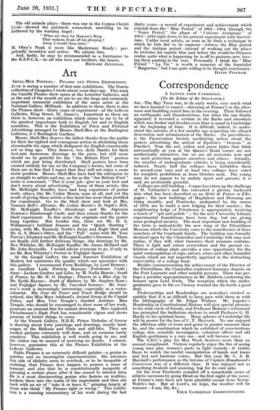Art
SBEIX-MEX POSTERS : PICASSO AND OTHER EXHIBITIONS.
JUNE is seeing a number of first-rate exhibitions. The Durrio collection of Gauguin I wrote about some days ago. This week
the Camille Pissaro show opens at the Leicester Galleries, and at the end of the month we are to see the large and extremely important memorial exhibition of the same artist at the National Gallery, Millbank. In addition to these, there is also the Picasso show—thirty years of experiment—at the Lefevre Galleries, King Street, St. James's. Important as these are there is, however, an exhibition which seems to me to be of the greatest impottance both to English Art and to English amenities. This is • the Exhibition of Press and Pictorial Advertising arranged by Messrs. Shell-Mex at the Burlington Galleries, 3-5 Burlington Gardens.
Messrs. Shell-Mex deserve the fullest thanks from the public for their far-sighted and courageous action in abolishing those abominable tin signs which disfigured the English countryside not so long ago. They deserve, too, daily thanks for their first-rate humorous drawings in the press, but still more should we be grateful for the " See Britain First " posters which are just being distributed. Shell posters have been created entirely for use on the Company's lorries, but some of them are so fine that I regret that they will not enjoy a more static position. Messrs. Shell-Mex have had the enterprise to go straight to artists and say, as far as the "See Britain First" series is concerned, " This is your job—give us your best and don't worry about advertising." Some of these artists, like Mr. McKnight Kauffer, have had long experience of poster work, others, like Mr. Cedric Morris, none at all, and yet the result of giving these artists a free hand has more than justified the experiment. .Go to the Shell show and look at Mrs. Vanessa Bell's Alfriston, Mr. Cedric Morris's St. Osyth's Mill, Mr. McKnight Kauffer's Stonehenge, and Mr. Algernon Newton's Bamborough Castle, and then return thanks for the Shell experiment. In this series the originals and the poster hang together. But besides this, there are Mr. H. S. Williamson's brilliant Seasons and the " Quick Starting " series, with Mr. Kennedy North's Snipe and Eagle Owls and Mr. G. S. Brien's Otters, and the " Pull " series with Mr. Tom Purvis's Elephant and Mr. McKnight Kauffer's Oarsman. There are finally still further delicious things—the drawings by Mr. Rex Whistler, Mr. McKnight Kauffer, Mr. James Holland and Mr. John Reynolds. I would advise everyone to go, if only to see Mr. Rex Whistler's Portent in Trafalgar Square.
At the Goupil Gallery the usual Summer Exhibition of Modem Art maintains the quality which one associates with this gallery. I recommend Farm Buildings, by Lord Bemers ; an excellent Lady Patricia Ramsay—Portchester Castle • Snow—Lexham Gardens and Lilac, by M. Nadia Benois ; South of France, by Mr. R. 0. Dunlop • Flowers in a Blue Jug, by Mr. Keith Baynes ; South of Barkers, by Mr. Stephen Bone ; and Trafalgar Square, by Mr. Vsevolod Sozonov. Mr. Sozo- nov's work is increasingly interesting—especially as a water- colourist. His Near the Tower and Tower Bridge should be noticed, also Miss Mary Adshead's Animal Group at the Crystal Palace, and Miss Vere Temple's Startled Antelope. Miss Temple, who should be encouraged to show more of her work, possesses an unusual flair for animal drawings. Miss Asphodel Fleisclunann's Hyde Park has considerable vigour and shows promise of better things to come. At the French Gallery, H.R.H. Prince Nicholas of Greece is showing about forty paintings and drawings, mostly land- scapes of the Balkans and Paris and still-lifes. They are modest pictures extremely well done, and on occasion rarely sensitive. This exhibition is well worth going to see, and the visitor can be assured of receiving no shocks. I cannot, however, guarantee this at the Picasso Exhibition at the Lefevre -Galleries. -
Pablo Picasso is an extremely difficult painter—a genius in patches and an incorrigible experimentalist. His admirers this side of idolatry seem to overlook, or to be incapable of realizing, that Picasso does happen to possess a sense of humour, and also that he is constitutionally incapable of pursuing a certain phase after it has ceased to interest him. He is a most disconcerting genius who fastens on realities, buckets them into the realm of the improbable and then sits back with an air of " take -it or leave it," grinning largely at those who -think " My- Picasso right or wrong." This exhibi- tion is a running commentary of his work during the last
thirty years—a record of experiment and achievement which extends from the " Blue Period " of 1901-1904, through the " Negro Period," the phase of " Cubisme Analytique " of 1914-1918 right down to his present experiment with Surreal- isme. Unlike most artists, as soon as he finds a technique in which he bids this to be supreme—witness the Blue period and the Antique period—instead of working out the phase he twitches his mantle blue and before the would-be-Picassos realize quite what is happening he is off to pastures new, leav- ing them panting in the rear. Personally I think the " Blue Period " " La Vie " is worth a museum of the Surrealist " Baigneuse," but I am quite willing to be thought reactionary.
DAVID FINCHAM.










































 Previous page
Previous page